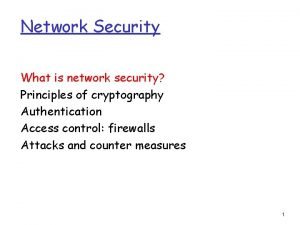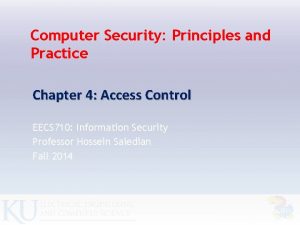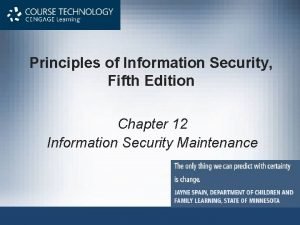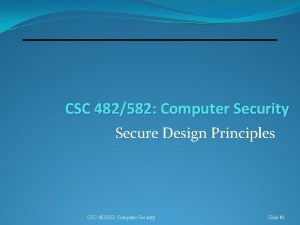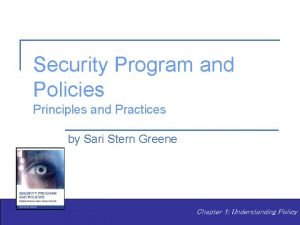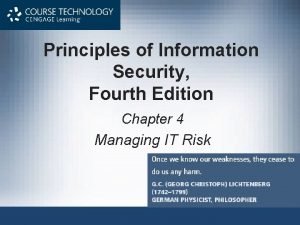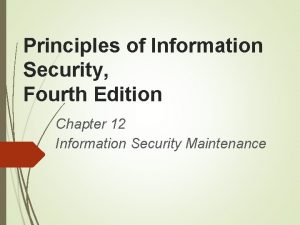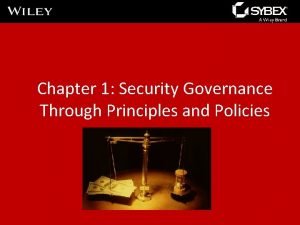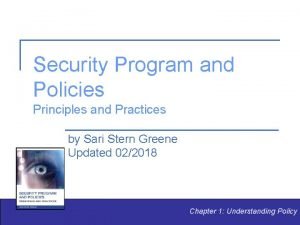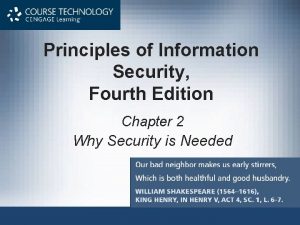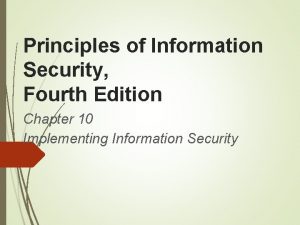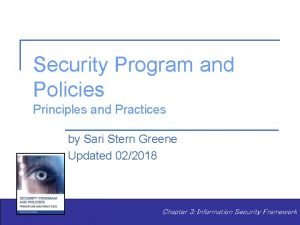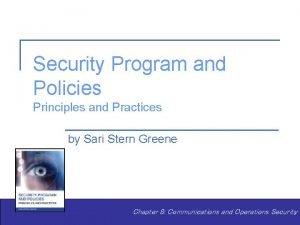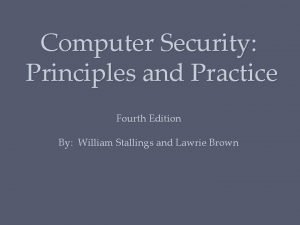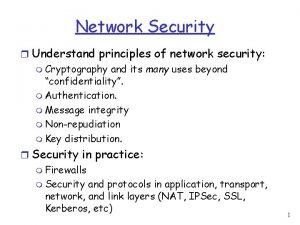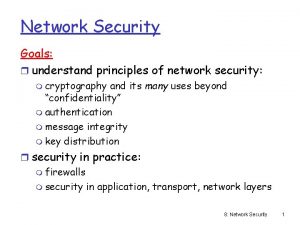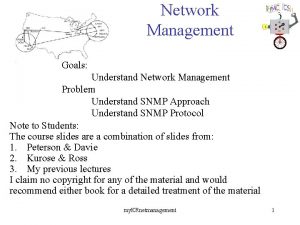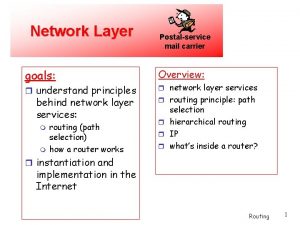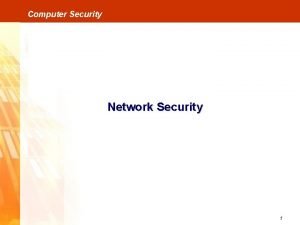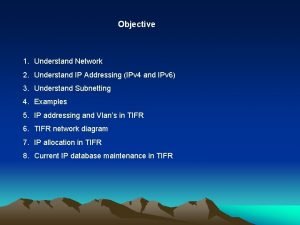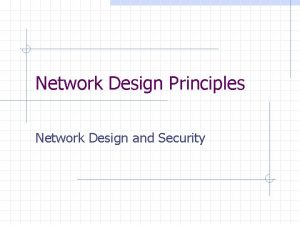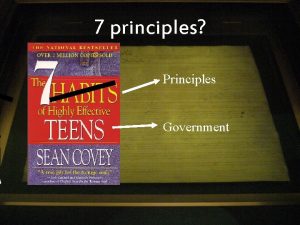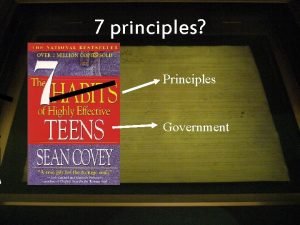Network Security r understand principles of network security








![Symmetric key crypto: DES: Data Encryption Standard r US encryption standard [NIST 1993] r Symmetric key crypto: DES: Data Encryption Standard r US encryption standard [NIST 1993] r](https://slidetodoc.com/presentation_image_h2/5c9529c9447a7001b878e46ec0bcf242/image-9.jpg)


























- Slides: 35

Network Security r understand principles of network security: m cryptography and its many uses beyond “confidentiality” m authentication m message integrity m key distribution r security in practice: m firewalls m security in application, transport, network, link layers Network Security

What is network security? Confidentiality: only sender, intended receiver should “understand” message contents m sender encrypts message m receiver decrypts message Authentication: sender, receiver want to confirm identity of each other Message Integrity: sender, receiver want to ensure message not altered (in transit, or afterwards) without detection Access and Availability: services must be accessible and available to users Network Security 2

Friends and enemies: Alice, Bob, Trudy r well-known in network security world r Bob, Alice (lovers!) want to communicate “securely” r Trudy (intruder) may intercept, delete, add messages Alice data channel secure sender Bob data, control messages secure receiver data Trudy Network Security

Who might Bob, Alice be? r … well, real-life Bobs and Alices! r Web browser/server for electronic transactions (e. g. , on-line purchases) r on-line banking client/server r DNS servers r routers exchanging routing table updates r other examples? Network Security 4

There are bad guys (and girls) out there! Q: What can a “bad guy” do? A: a lot! m eavesdrop: intercept messages m actively insert messages into connection m impersonation: can fake (spoof) source address in packet (or any field in packet) m hijacking: “take over” ongoing connection by removing sender or receiver, inserting himself in place m denial of service: prevent service from being used by others (e. g. , by overloading resources) Network Security 5

The language of cryptography Alice’s K encryption A key plaintext encryption algorithm Bob’s K decryption B key ciphertext decryption plaintext algorithm symmetric key crypto: sender, receiver keys identical public-key crypto: encryption key public, decryption key secret (private) Network Security 6

Symmetric key cryptography substitution cipher: substituting one thing for another m monoalphabetic cipher: substitute one letter for another plaintext: abcdefghijklmnopqrstuvwxyz ciphertext: mnbvcxzasdfghjklpoiuytrewq E. g. : Plaintext: bob. i love you. alice ciphertext: nkn. s gktc wky. mgsbc Network Security 7

Symmetric key cryptography KA-B plaintext message, m encryption ciphertext algorithm K (m) A-B decryption plaintext algorithm m=K A-B ( KA-B(m) ) symmetric key crypto: Bob and Alice share know same (symmetric) key: K A-B r e. g. , key is knowing substitution pattern in mono alphabetic substitution cipher Network Security 8
![Symmetric key crypto DES Data Encryption Standard r US encryption standard NIST 1993 r Symmetric key crypto: DES: Data Encryption Standard r US encryption standard [NIST 1993] r](https://slidetodoc.com/presentation_image_h2/5c9529c9447a7001b878e46ec0bcf242/image-9.jpg)
Symmetric key crypto: DES: Data Encryption Standard r US encryption standard [NIST 1993] r 56 -bit symmetric key, 64 -bit plaintext input r How secure is DES? m DES Challenge: 56 -bit-key-encrypted phrase (“Strong cryptography makes the world a safer place”) decrypted (brute force) in 4 months m no known “backdoor” decryption approach r making DES more secure: m use three keys sequentially (3 -DES) on each datum m use cipher-block chaining Network Security 9

Symmetric key crypto: DES operation initial permutation 16 identical “rounds” of function application, each using different 48 bits of key final permutation Network Security 10

AES: Advanced Encryption Standard r new (Nov. 2001) symmetric-key NIST standard, replacing DES r processes data in 128 bit blocks r 128, 192, or 256 bit keys r brute force decryption (try each key) taking 1 sec on DES, takes 149 trillion years for AES Network Security 11

Public Key Cryptography symmetric key crypto r requires sender, receiver know shared secret key r Q: how to agree on key in first place (particularly if never “met”)? public key cryptography r radically different approach [Diffie. Hellman 76, RSA 78] r sender, receiver do not share secret key r public encryption key known to all r private decryption key known only to receiver Network Security

Public key cryptography + Bob’s public B key K K plaintext message, m encryption ciphertext algorithm + K (m) B - Bob’s private B key decryption plaintext algorithm message + m = K B(K (m)) B Network Security

Public key encryption algorithms Requirements: 1 2 . . + need K B( ) and K - ( ) such that B - + K (K (m)) = m B B + given public key KB , it should be impossible to compute private key K B RSA: Rivest, Shamir, Adelson algorithm Network Security 14

RSA: Choosing keys 1. Choose two large prime numbers p, q. (e. g. , 1024 bits each) 2. Compute n = pq, z = (p-1)(q-1) 3. Choose e (with e<n) that has no common factors with z. (e, z are “relatively prime”). 4. Choose d such that ed-1 is exactly divisible by z. (in other words: ed mod z = 1 ). 5. Public key is (n, e). Private key is (n, d). + KB - KB Network Security 15

RSA: Encryption, decryption 0. Given (n, e) and (n, d) as computed above 1. To encrypt bit pattern, m, compute e e c = m mod n (i. e. , remainder when m is divided by n) 2. To decrypt received bit pattern, c, compute d m = c d mod n (i. e. , remainder when c is divided by n) Magic d m = (m e mod n) mod n happens! c Network Security 16

RSA: another important property The following property will be very useful later: - + B B K (K (m)) + = m = K (K (m)) B B use public key first, followed by private key use private key first, followed by public key Result is the same! Network Security 17

Authentication Goal: Bob wants Alice to “prove” her identity to him Protocol ap 1. 0: Alice says “I am Alice” Failure scenario? ? Network Security 18

Authentication Goal: Bob wants Alice to “prove” her identity to him Protocol ap 1. 0: Alice says “I am Alice” in a network, Bob can not “see” Alice, so Trudy simply declares herself to be Alice Network Security 19

Authentication: another try Protocol ap 2. 0: Alice says “I am Alice” in an IP packet containing her source IP address Alice’s “I am Alice” IP address Failure scenario? ? Network Security 20

Authentication: another try Protocol ap 2. 0: Alice says “I am Alice” in an IP packet containing her source IP address Alice’s IP address Trudy can create a packet “spoofing” “I am Alice” Alice’s address Network Security 21

Authentication: another try Protocol ap 3. 0: Alice says “I am Alice” and sends her secret password to “prove” it. Alice’s “I’m Alice” IP addr password Alice’s IP addr OK Failure scenario? ? Network Security 22

Authentication: another try Protocol ap 3. 0: Alice says “I am Alice” and sends her secret password to “prove” it. Alice’s “I’m Alice” IP addr password Alice’s IP addr OK playback attack: Trudy records Alice’s packet and later plays it back to Bob Alice’s “I’m Alice” IP addr password Network Security 23

Authentication: yet another try Protocol ap 3. 1: Alice says “I am Alice” and sends her encrypted secret password to “prove” it. Alice’s encrypted “I’m Alice” IP addr password Alice’s IP addr OK Failure scenario? ? Network Security 24

Authentication: another try Protocol ap 3. 1: Alice says “I am Alice” and sends her encrypted secret password to “prove” it. Alice’s encryppted “I’m Alice” IP addr password Alice’s IP addr OK record and playback still works! Alice’s encrypted “I’m Alice” IP addr password Network Security 25

Authentication: yet another try Goal: avoid playback attack Nonce: number (R) used only once –in-a-lifetime ap 4. 0: to prove Alice “live”, Bob sends Alice nonce, R. Alice must return R, encrypted with shared secret key “I am Alice” R KA-B(R) Failures, drawbacks? Alice is live, and only Alice knows key to encrypt nonce, so it must be Alice! Network Security 26

Digital Signatures Cryptographic technique analogous to hand-written signatures. r sender (Bob) digitally signs document, establishing he is document owner/creator. r verifiable, nonforgeable: recipient (Alice) can prove to someone that Bob, and no one else (including Alice), must have signed document Network Security

Digital Signatures Simple digital signature for message m: r Bob signs m by encrypting with his private key KB-, creating “signed” message, KB-(m) Bob’s message, m Dear Alice Oh, how I have missed you. I think of you all the time! …(blah) K B Bob’s private key Public key encryption algorithm K B(m) Bob’s message, m, signed (encrypted) with his private key Bob Network Security

Digital Signatures (more) - r Suppose Alice receives msg m, digital signature KB(m) r Alice verifies m signed by Bob by applying Bob’s + - public key KB to KB(m) then checks KB(KB(m) ) = m. + - r If KB(KB(m) ) = m, whoever signed m must have used Bob’s private key. Alice thus verifies that: ü ü ü Bob signed m. No one else signed m. Bob signed m and not m’. Non-repudiation: ü Alice can take m, and signature KB(m) to-court and prove that Bob signed m. Network Security

Message Digests Computationally expensive to public-key-encrypt long messages Goal: fixed-length, easyto-compute digital “fingerprint” r apply hash function H to m, get fixed size message digest, H(m). large message m H: Hash Function H(m) Hash function properties: r many-to-1 r produces fixed-size msg digest (fingerprint) r given message digest x, computationally infeasible to find m such that x = H(m) Network Security

Digital signature = signed message digest Alice verifies signature and integrity of digitally signed message: Bob sends digitally signed message: large message m H: Hash function Bob’s private key + - KB encrypted msg digest H(m) digital signature (encrypt) encrypted msg digest KB(H(m)) large message m H: Hash function KB(H(m)) Bob’s public key + KB digital signature (decrypt) H(m) equal ? Network Security

Trusted Intermediaries Symmetric key problem: r How do two entities establish shared secret key over network? Solution: r trusted key distribution center (KDC) acting as intermediary between entities Public key problem: r When Alice obtains Bob’s public key (from web site, e-mail, diskette), how does she know it is Bob’s public key, not Trudy’s? Solution: r trusted certification authority (CA) Network Security

Key Distribution Center (KDC) r Alice, Bob need shared symmetric key. r KDC: server shares different secret key with each registered user (many users) r Alice, Bob know own symmetric keys, KA-KDC KB-KDC , for communicating with KDC KA-KDC KP-KDC KB-KDC KA-KDC KX-KDC KY-KDC KB-KDC KZ-KDC Network Security 33

Certification Authorities r Certification authority (CA): binds public key to particular entity, E. r E (person, router) registers its public key with CA. m m m E provides “proof of identity” to CA. CA creates certificate binding E to its public key. certificate containing E’s public key digitally signed by CA – CA says “this is E’s public key” Bob’s public key Bob’s identifying information + KB digital signature (encrypt) CA private key K- CA + KB certificate for Bob’s public key, signed by CA Network Security 34

Certification Authorities r When Alice wants Bob’s public key: m gets Bob’s certificate (Bob or elsewhere). m apply CA’s public key to Bob’s certificate, get Bob’s public key + KB digital signature (decrypt) CA public key Bob’s public + key KB + K CA Network Security 35
 To understand recursion you must understand recursion
To understand recursion you must understand recursion Security security security
Security security security Letoutr
Letoutr Firewall design principles
Firewall design principles Osi security services
Osi security services Guide to network security
Guide to network security Wireless security in cryptography and network security
Wireless security in cryptography and network security Electronic mail security in network security
Electronic mail security in network security Security guide to network security fundamentals
Security guide to network security fundamentals Security guide to network security fundamentals
Security guide to network security fundamentals Sdlc principles and practices
Sdlc principles and practices Principles of information security 5th edition pdf
Principles of information security 5th edition pdf Computer security principles and practice
Computer security principles and practice Computer security principles and practice solutions
Computer security principles and practice solutions 12 principles of information security
12 principles of information security Principle of fail-safe defaults example
Principle of fail-safe defaults example Security program and policies principles and practices
Security program and policies principles and practices Principles of information systems, seventh edition
Principles of information systems, seventh edition Principles of information security 4th edition
Principles of information security 4th edition 12 principles of information security
12 principles of information security Aaa triad in information security
Aaa triad in information security Security program and policies principles and practices
Security program and policies principles and practices Principles of information security 4th edition
Principles of information security 4th edition Principles of information security 4th edition
Principles of information security 4th edition Computer security principles and practice 4th edition
Computer security principles and practice 4th edition Security program and policies principles and practices
Security program and policies principles and practices Security program and policies principles and practices
Security program and policies principles and practices Collective security
Collective security Principles of computer security
Principles of computer security Computer security principles and practice
Computer security principles and practice History helps us to understand other people
History helps us to understand other people Quran easy to understand
Quran easy to understand Understand quran
Understand quran Understand quran and salah the easy way
Understand quran and salah the easy way Understand algebraic expressions
Understand algebraic expressions Understand your role care certificate
Understand your role care certificate


